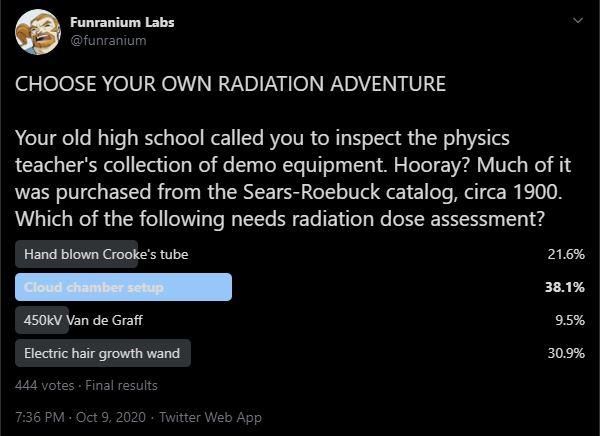When you’re regarded as a teacher/professor’s favorite student over their entire career, it makes it very likely the school administration or alumni association will drop you a line for help, no matter what you went on to do in life.
This may encourage you to move far from home.
[The tenth in an ongoing series of my compiled explainers for my CHOOSE YOUR OWN RADIATION ADVENTURE quizzes. There’s never really a right answer but some might work out better under the constraints of the scenario. It’s like poetry, really.]
- Where/how old is your school district?
- How comfortable are they are using it?
- How likely is it to break/easy to fix again?
- Have they been specifically forbidden to use it by administration?
The collection your teacher has to draw on is made up of the collective things ALL the science teachers that have ever taught there have left behind, everything of their own, and everything donated to the district over the decades. Because if you can give it away, and they accept it, it isn’t waste and you get a tax write off for the donation. You know, for kids! SEE ALSO: Navy base cleanup CYORA
It’s entirely likely the four items in this quiz are in the demo collection. For example, Luis Alvarez, his students, and Oppenheimer’s sons used to build cloud chambers and hand them out to anyone and everyone that wanted one within a several hundred mile radius of Berkeley, CA. What they didn’t typically give were radioactive sources to go with the cloud chamber. Not because the rules were strict or that the Nobel Prize winner was stingy but rather because a suitable radioactive source was very easy to lay hands on for most anyone those days. If it isn’t already mounted in the cloud chamber, there’s likely a box somewhere near it with a Ra-226 tipped needle or a small piece of pitchblende. Of course, this might be when you find the cabinet with a century worth of collected rad sources, but that’s a different CYORA. Old enough radium needles and crumbly ore will shed material, which is annoying and you have to clean up, but they aren’t a big dose concern. Use your GM to find all the bits and bag them all nicely.
But even in this blighted Year of Nergal 2020, your cloud chamber and the associated bits are probably the newest of the four at ~80 years old. Sears-Roebuck, however, made ABSOLUTE BANK selling medical quackery, pretty much from the first 1894 catalog. I’m not going to link to any of the modern inheritors of the 19th century hair growth stimulation wands, but suffice it to say this product class has never really gone away. Various specific products have been pulled from the market over the decades and dozens of new ones take their place. In summation, yes, I know all about the damn laser hats and have reported several to the FDA. Speaking of the FDA, as many of you noted, the peak of electricity based quack devices matches nicely with the rise of the radiation-based ones. And this all predates the Clean Food & Drug Act.
Speaking of electrical fun, this brings us to the Van de Graff generator. A 450kV Van de Graff is about this size and works roughly like so for fun demos.
A Crooke’s Tube is more generically known as a cathode ray tube (CRT). CRT covers everything from this 19th century delight, to your old tube TV, to your x-ray unit. What they all have in common are electrodes, glass, vacuum, voltage…and the generation of x-rays. Did you notice the sound in that nine second video? That was their rad meter out of the shot reacting to all the x-rays emitted when voltage was applied to the tube. Very old tubes still function, though you may need to bake them out a bit before they’ll work well enough to give you a good glow. But why didn’t you ever hear about x-rays from your old TV’s CRT? Ever notice how heavy those damn things were compared to your flatscreen? Because we learned lessons quickly and added a bunch of lead to the tubes of consumer products. We also made the FDA’s responsible for them after one holiday shopping season production whoopsie.
The Crooke’s Tubes have none of that. Their soft x-ray emission *and how it aims* is a function of applied voltage, target material, how good the vacuum is, and what magnets you add. Some are highly directional. Others spew x-rays EVERYWHERE. Get your meter for this one. And I use the plural “tubes” because no self-respecting teacher has just one, unless that’s the only one left intact after a century of instruction. For public instruction, you want the dose rate <2µSv/hr. You might discover you need to move some desks to use them.
For the inspiring events for this scenario, while my high school physics/chemistry teacher had all the things listed in the quiz and so much more (especially the Sears medical quackery instruments), P.Q. le Boom’s Collection is not the subject in question here.
PROTIP: Do not aim your tube at students. That’s rude. Use a camera if you want them to see the Maltese Cross shadow.
At a basic level, they needed to determine if there were any dose rates in excess .2µSv/hr in the classroom.
ANSWER: Each and every one of the tubes was in excess of that for the professor at the front of the classroom. But that’s fine, they’re rad workers.
~fin~
